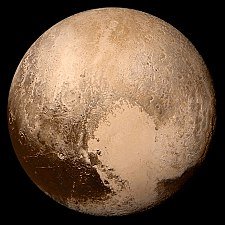Few actions in the world of science have upset the general public like the demotion of Pluto. But the distant sphere no longer qualifies as a planet.
When Pluto was discovered in 1930 much less was known about the Solar System than is known now, and the discovery of a distant object fit nicely into the scheme of things in 1930. For one thing, the famous astronomer Percival Lowell has long predicted the existence of a planet near the actual location of Pluto where Clyde Tombaugh discovered it. Today most astronomers agree that Pluto’s position in 1930 was coincidental to Lowell’s prediction.

Full-disc view of Pluto in near-true color - image credit
Also, early estimates of Pluto’s mass were nearly that of the Earth. Its diameter was thought to be larger than Mercury. With the passage of time, Pluto’s size was constantly revised downward, and its orbit was found to be so eccentric that it is occasionally closer to the Sun than Neptune.
Pluto’s Demotion was a Result of New Knowledge About the Solar System
The downgrading of Pluto wasn’t simply an act of defiance. It became clear that astronomers had given little thought early on to the notion that the Solar System was as complex as we now know it is. There was no Oort Cloud, few asteroids, no trans-Neptunian objects, no Kuiper Belt.
Space probes have made discoveries that have marveled and amazed scientists. Complex cosmological theories boggle the imagination. There was not a clear and precise definition of planet. Planets were simply large, round objects that orbited the Sun, yet not even the size of a planet specified.
In 2005 a large Kuiper Belt object was discovered and determined to be larger than Pluto. To complicate matters, the new object – Eris – had a satellite. Other similar objects had been discovered before Eris, but none were so large.
There was a need to modernize the description of the Solar System. In 2006 The International Astronomical Union was more or less forced into a position of demoting Pluto. It was designated as a dwarf planet – a title held by an increasingly large number of objects beyond Pluto.
The newly found members of the Solar System typically have orbital characteristics more in line with Pluto’s orbit – highly eccentric orbits that are greatly inclined to the ecliptic – the plane of the Sun’s equator. The plane of the eight planets is generally less than 2 degrees with Mercury being the sole exception at nearly 7 degrees. Pluto is inclined at a whopping 17degrees and Eris sails a lop-sided 44 degrees above the ecliptic.
Many people protested the demotion, but Pluto still has the distinction of being the first Kuiper Belt object discovered and it was the first one with known satellites.
Now Planets are more Precisely Defined
The change in the classification, though unpopular, was typical of the way science is supposed to work. Science is dynamic. Things change as new information becomes available: fungi were once classified as plants; Galileo was convicted of heresy for his discoveries that eventually advanced astronomy as a science.
The IAU has now defined a planet in terms that take into account Pluto’s differences from the other planets. The definition has three main components:
- A planet is a body that orbits the Sun;
- It has sufficient mass for its gravity to make it round;
- It has cleared its neighborhood of smaller objects around its orbit.
Pluto has Other Issues that Differentiate it from the Planets
Pluto fails on the third definition, which is far more complex than it sounds and has not gained universal agreement. Indeed, there are still efforts to reclassify Pluto to its original status as a planet. But Pluto seems clearly different in other ways.
For example:
- its orbital properties compare more favorably to other dwarf planets
- its three satellites have combined masses relatively large compared to Pluto
- the center of gravity between Pluto and its satellites – Charon, Nix, and Hydra – lies outside the planet – i.e., the four - - - objects revolve around a common center of gravity – the barycenter –, rather than one around the other
Pluto compares well size-wise with several other dwarf planets, being slightly smaller than Eris and somewhat larger than several others.
The Pluto Issue is not Settled Yet
As has been mentioned, some experts disagree with the IAU decision, but clearly decisions have to be made that address the discoveries about the Solar System made in the past three decades or so. There are clearly objects that don’t behave like planets.
One choice would be to designate as planets all round objects that have a unique orbit around the Sun, but that would increase the number of planets to over twenty and necessarily include Ceres, the largest asteroid. There will undoubtedly be many more dwarf planets discovered.
Current efforts to classify the bewildering number of objects in the Solar System are based largely on orbital characteristics. One subset of objects is currently called plutoids. Not surprisingly, these objects have orbital configurations similar to Pluto.
There is much work to be done and much to consider, but a system of classification of Solar System objects is badly needed. Whatever the final result is, it remains likely that Pluto will dominate another class, rather than be the lonely and last planet, and that seems fitting for the popular little wanderer.
Sources:
Aguilar, David A. 13 Planets: The Latest View of the Solar System. National Geographic. Margate. https://www.goodreads.com/book/show/9923038-13-planets
“Why is Pluto no longer considered a planet?” https://science.howstuffworks.com/pluto-planet.htm
As we learn more about the complexity of both our own and other solar systems, the whole concept of planets is starting to feel a bit outdated. I believe the term "planemo" is going to gain more popularity in the future, maybe divided into subclasses.
Downvoting a post can decrease pending rewards and make it less visible. Common reasons:
Submit